handbrake BMW 528XI SEDAN 2007 E60 Owner's Manual
[x] Cancel search | Manufacturer: BMW, Model Year: 2007, Model line: 528XI SEDAN, Model: BMW 528XI SEDAN 2007 E60Pages: 286, PDF Size: 9.31 MB
Page 15 of 286
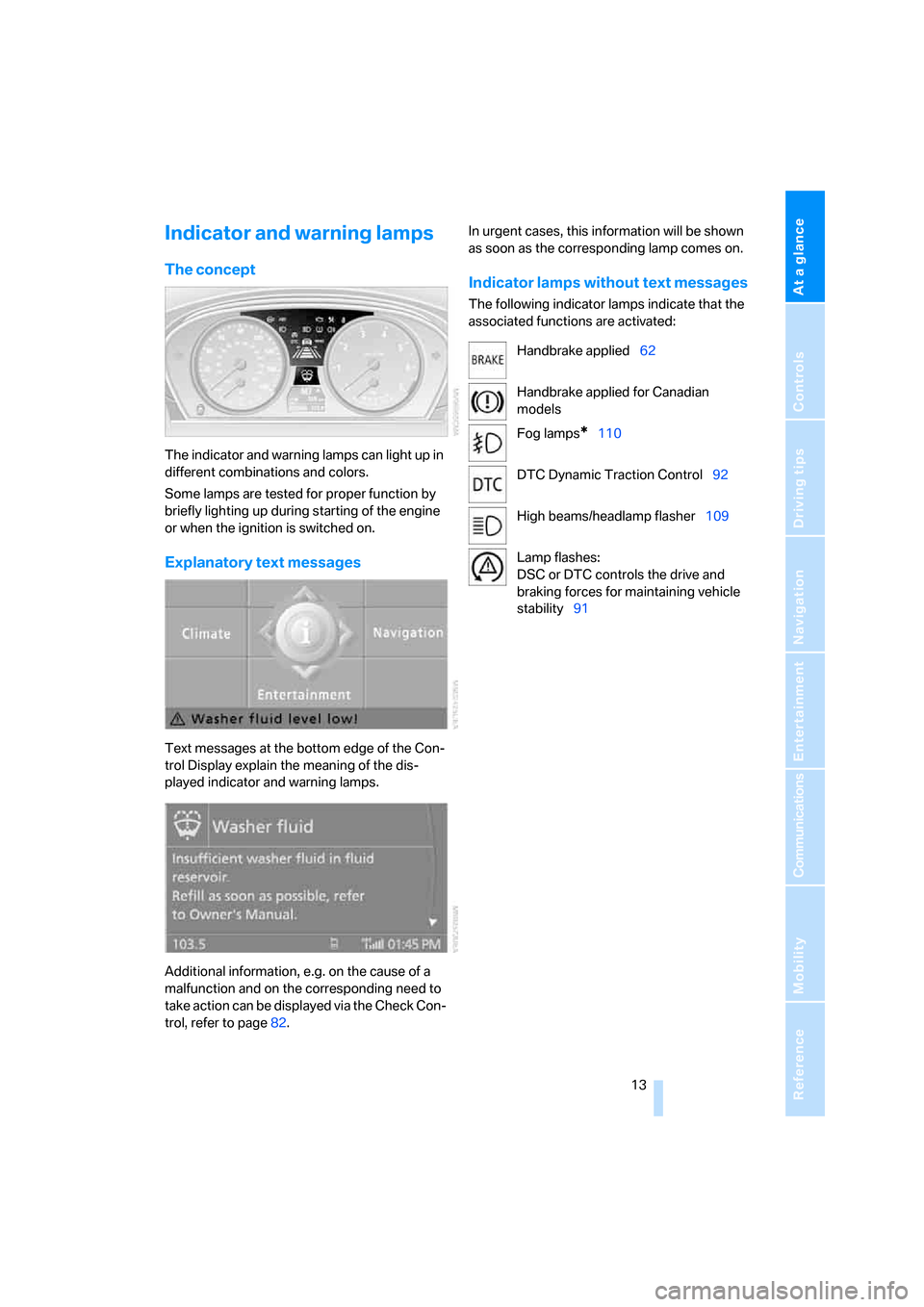
At a glance
13Reference
Controls
Driving tips
Communications
Navigation
Entertainment
Mobility
Indicator and warning lamps
The concept
The indicator and warning lamps can light up in
different combinations and colors.
Some lamps are tested for proper function by
briefly lighting up during starting of the engine
or when the ignition is switched on.
Explanatory text messages
Text messages at the bottom edge of the Con-
trol Display explain the meaning of the dis-
played indicator and warning lamps.
Additional information, e.g. on the cause of a
malfunction and on the corresponding need to
take action can be displayed via the Check Con-
trol, refer to page82.In urgent cases, this information will be shown
as soon as the corresponding lamp comes on.
Indicator lamps without text messages
The following indicator lamps indicate that the
associated functions are activated:
Handbrake applied62
Handbrake applied for Canadian
models
Fog lamps
*110
DTC Dynamic Traction Control92
High beams/headlamp flasher109
Lamp flashes:
DSC or DTC controls the drive and
braking forces for maintaining vehicle
stability91
Page 63 of 286
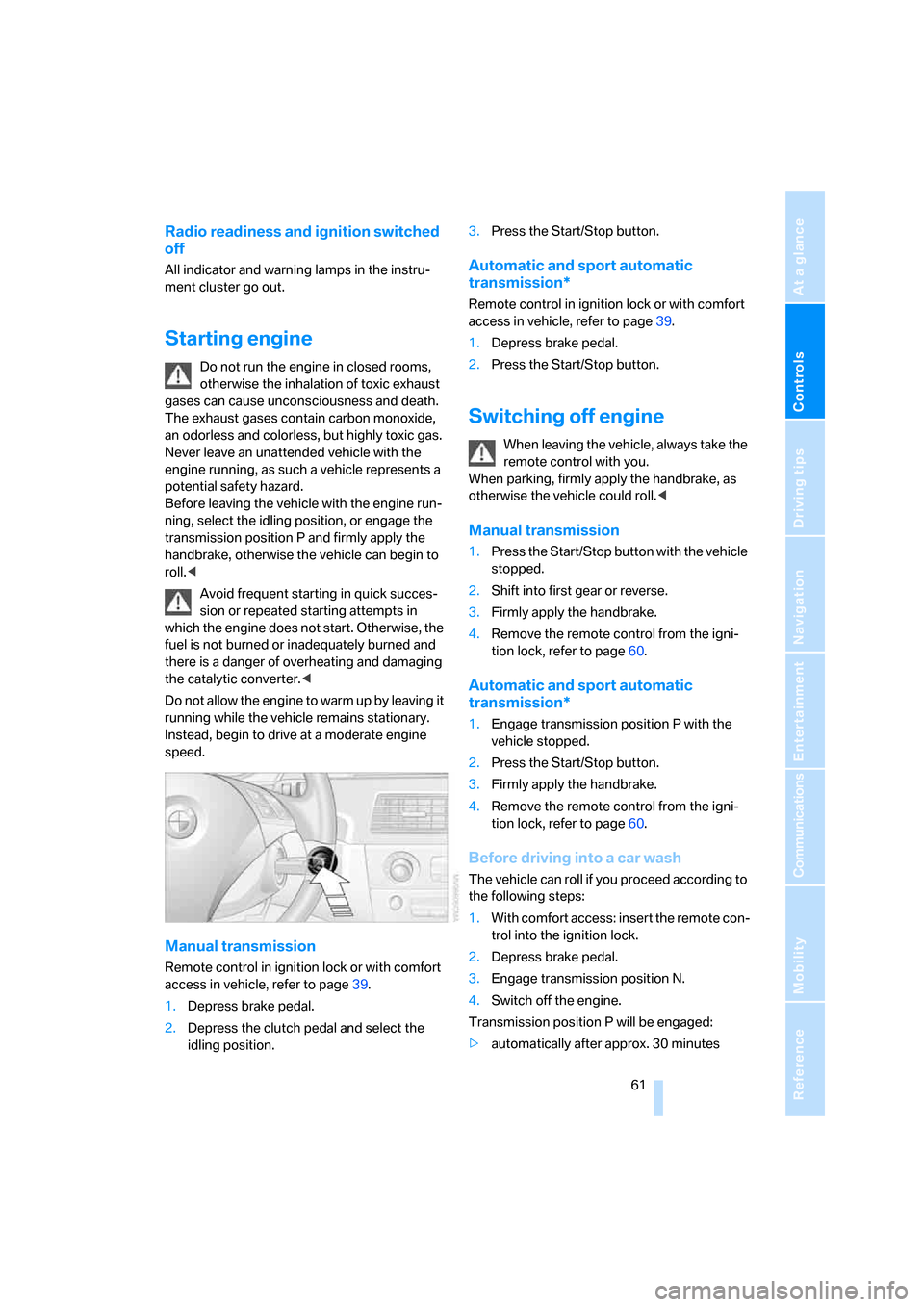
Controls
61Reference
At a glance
Driving tips
Communications
Navigation
Entertainment
Mobility
Radio readiness and ignition switched
off
All indicator and warning lamps in the instru-
ment cluster go out.
Starting engine
Do not run the engine in closed rooms,
otherwise the inhalation of toxic exhaust
gases can cause unconsciousness and death.
The exhaust gases contain carbon monoxide,
an odorless and colorless, but highly toxic gas.
Never leave an unattended vehicle with the
engine running, as such a vehicle represents a
potential safety hazard.
Before leaving the vehicle with the engine run-
ning, select the idling position, or engage the
transmission position P and firmly apply the
handbrake, otherwise the vehicle can begin to
roll.<
Avoid frequent starting in quick succes-
sion or repeated starting attempts in
which the engine does not start. Otherwise, the
fuel is not burned or inadequately burned and
there is a danger of overheating and damaging
the catalytic converter.<
Do not allow the engine to warm up by leaving it
running while the vehicle remains stationary.
Instead, begin to drive at a moderate engine
speed.
Manual transmission
Remote control in ignition lock or with comfort
access in vehicle, refer to page39.
1.Depress brake pedal.
2.Depress the clutch pedal and select the
idling position.3.Press the Start/Stop button.
Automatic and sport automatic
transmission*
Remote control in ignition lock or with comfort
access in vehicle, refer to page39.
1.Depress brake pedal.
2.Press the Start/Stop button.
Switching off engine
When leaving the vehicle, always take the
remote control with you.
When parking, firmly apply the handbrake, as
otherwise the vehicle could roll.<
Manual transmission
1.Press the Start/Stop button with the vehicle
stopped.
2.Shift into first gear or reverse.
3.Firmly apply the handbrake.
4.Remove the remote control from the igni-
tion lock, refer to page60.
Automatic and sport automatic
transmission*
1.Engage transmission position P with the
vehicle stopped.
2.Press the Start/Stop button.
3.Firmly apply the handbrake.
4.Remove the remote control from the igni-
tion lock, refer to page60.
Before driving into a car wash
The vehicle can roll if you proceed according to
the following steps:
1.With comfort access: insert the remote con-
trol into the ignition lock.
2.Depress brake pedal.
3.Engage transmission position N.
4.Switch off the engine.
Transmission position P will be engaged:
>automatically after approx. 30 minutes
Page 64 of 286
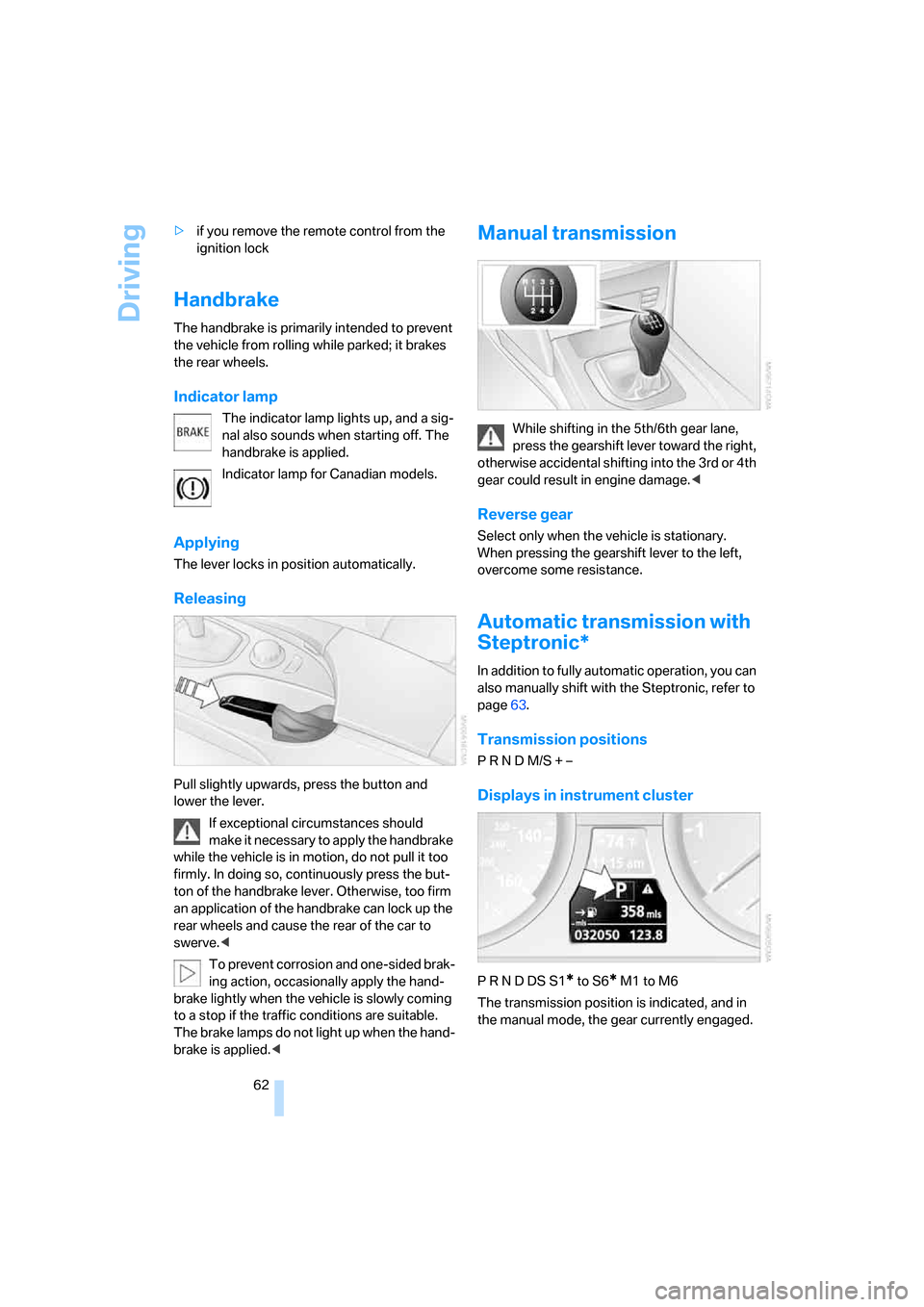
Driving
62 >if you remove the remote control from the
ignition lock
Handbrake
The handbrake is primarily intended to prevent
the vehicle from rolling while parked; it brakes
the rear wheels.
Indicator lamp
The indicator lamp lights up, and a sig-
nal also sounds when starting off. The
handbrake is applied.
Indicator lamp for Canadian models.
Applying
The lever locks in position automatically.
Releasing
Pull slightly upwards, press the button and
lower the lever.
If exceptional circumstances should
make it necessary to apply the handbrake
while the vehicle is in motion, do not pull it too
firmly. In doing so, continuously press the but-
ton of the handbrake lever. Otherwise, too firm
an application of the handbrake can lock up the
rear wheels and cause the rear of the car to
swerve.<
To prevent corrosion and one-sided brak-
ing action, occasionally apply the hand-
brake lightly when the vehicle is slowly coming
to a stop if the traffic conditions are suitable.
The brake lamps do not light up when the hand-
brake is applied.<
Manual transmission
While shifting in the 5th/6th gear lane,
press the gearshift lever toward the right,
otherwise accidental shifting into the 3rd or 4th
gear could result in engine damage.<
Reverse gear
Select only when the vehicle is stationary.
When pressing the gearshift lever to the left,
overcome some resistance.
Automatic transmission with
Steptronic*
In addition to fully automatic operation, you can
also manually shift with the Steptronic, refer to
page63.
Transmission positions
P R N D M/S + –
Displays in instrument cluster
P R N D DS S1* to S6* M1 to M6
The transmission position is indicated, and in
the manual mode, the gear currently engaged.
Page 66 of 286
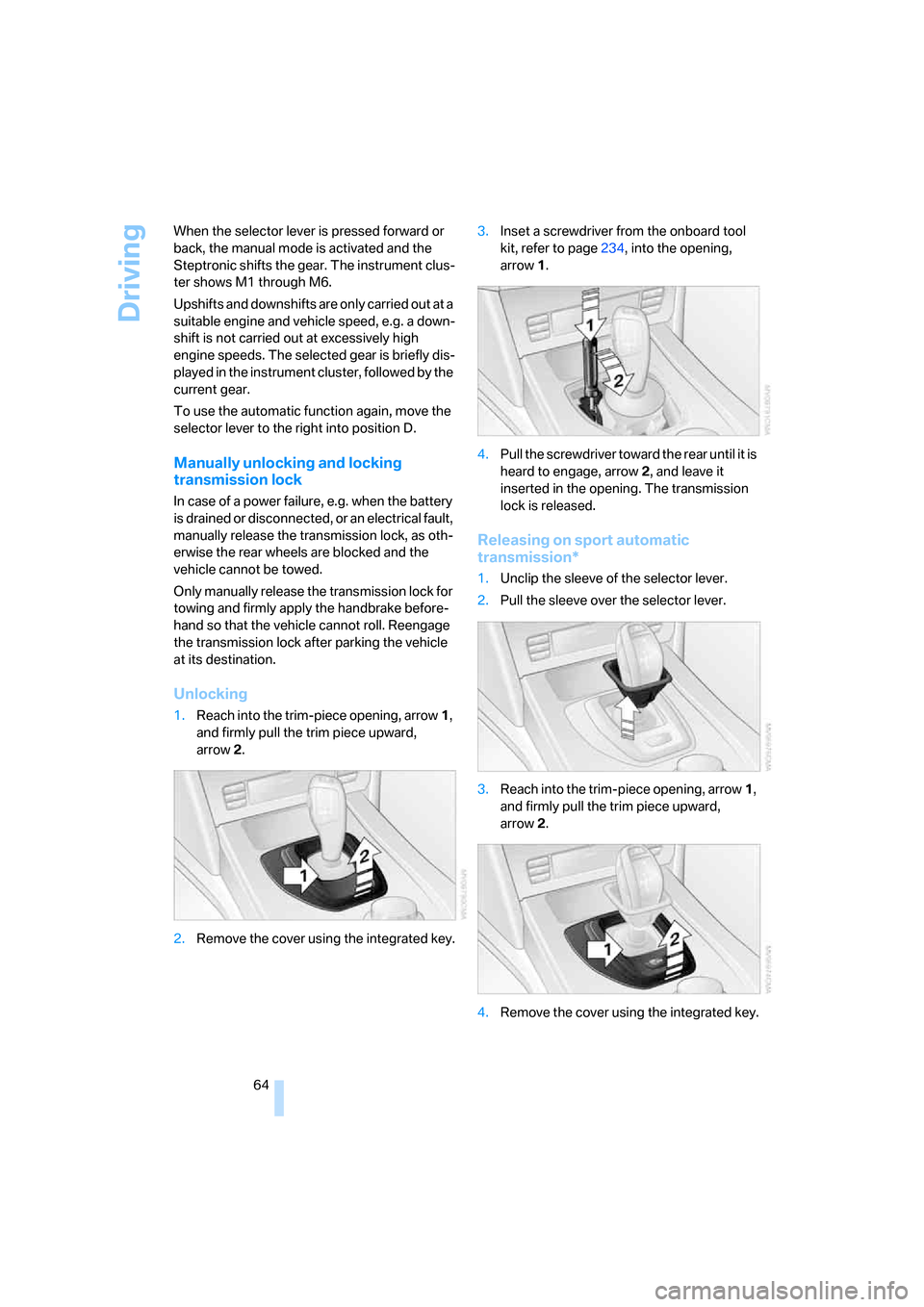
Driving
64 When the selector lever is pressed forward or
back, the manual mode is activated and the
Steptronic shifts the gear. The instrument clus-
ter shows M1 through M6.
Upshifts and downshifts are only carried out at a
suitable engine and vehicle speed, e.g. a down-
shift is not carried out at excessively high
engine speeds. The selected gear is briefly dis-
played in the instrument cluster, followed by the
current gear.
To use the automatic function again, move the
selector lever to the right into position D.
Manually unlocking and locking
transmission lock
In case of a power failure, e.g. when the battery
is drained or disconnected, or an electrical fault,
manually release the transmission lock, as oth-
erwise the rear wheels are blocked and the
vehicle cannot be towed.
Only manually release the transmission lock for
towing and firmly apply the handbrake before-
hand so that the vehicle cannot roll. Reengage
the transmission lock after parking the vehicle
at its destination.
Unlocking
1.Reach into the trim-piece opening, arrow1,
and firmly pull the trim piece upward,
arrow2.
2.Remove the cover using the integrated key.3.Inset a screwdriver from the onboard tool
kit, refer to page234, into the opening,
arrow1.
4.Pull the screwdriver toward the rear until it is
heard to engage, arrow2, and leave it
inserted in the opening. The transmission
lock is released.
Releasing on sport automatic
transmission*
1.Unclip the sleeve of the selector lever.
2.Pull the sleeve over the selector lever.
3.Reach into the trim-piece opening, arrow1,
and firmly pull the trim piece upward,
arrow2.
4.Remove the cover using the integrated key.
Page 71 of 286
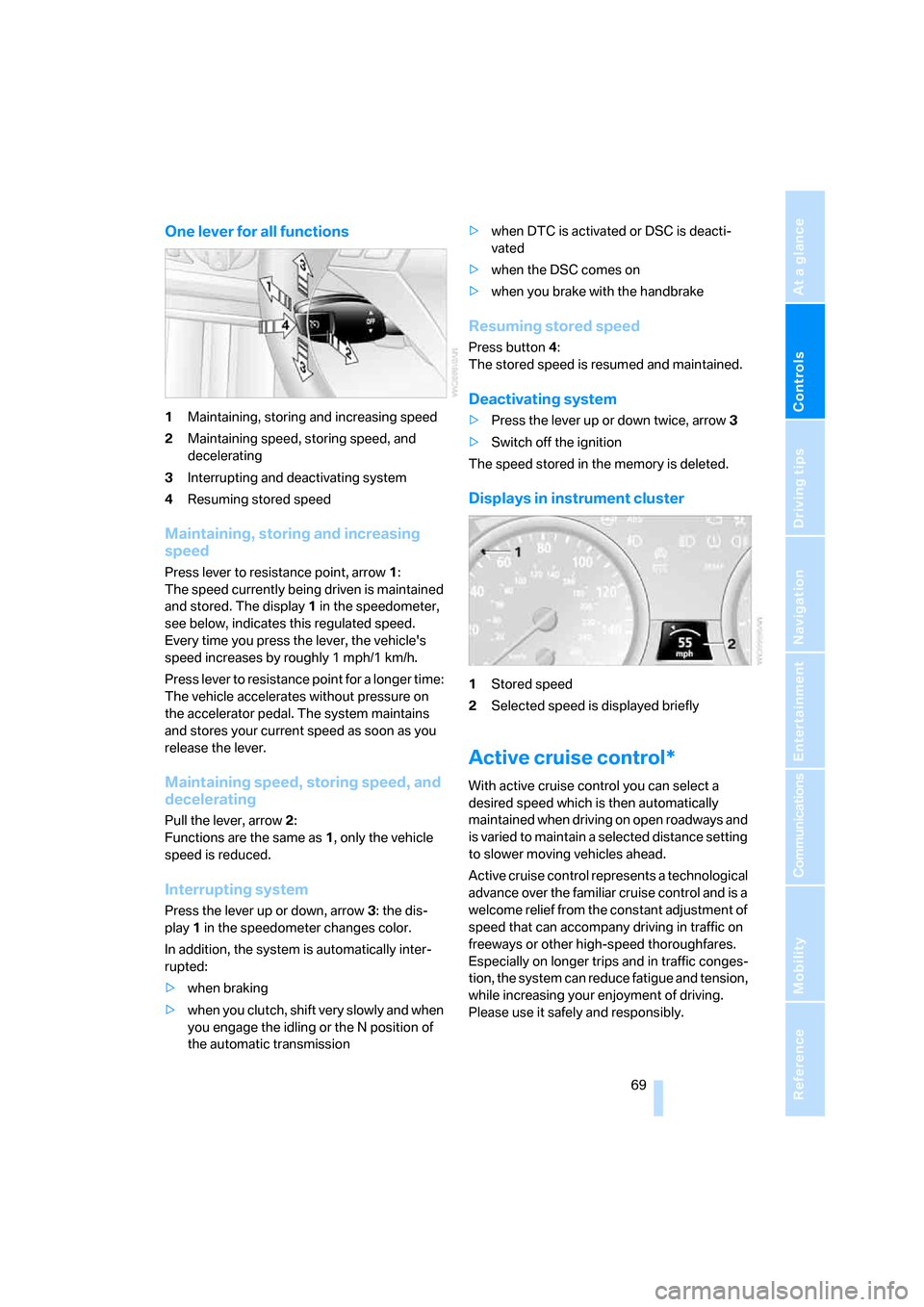
Controls
69Reference
At a glance
Driving tips
Communications
Navigation
Entertainment
Mobility
One lever for all functions
1Maintaining, storing and increasing speed
2Maintaining speed, storing speed, and
decelerating
3Interrupting and deactivating system
4Resuming stored speed
Maintaining, storing and increasing
speed
Press lever to resistance point, arrow 1:
The speed currently being driven is maintained
and stored. The display1 in the speedometer,
see below, indicates this regulated speed.
Every time you press the lever, the vehicle's
speed increases by roughly 1 mph/1 km/h.
Press lever to resistance point for a longer time:
The vehicle accelerates without pressure on
the accelerator pedal. The system maintains
and stores your current speed as soon as you
release the lever.
Maintaining speed, storing speed, and
decelerating
Pull the lever, arrow2:
Functions are the same as1, only the vehicle
speed is reduced.
Interrupting system
Press the lever up or down, arrow3: the dis-
play1 in the speedometer changes color.
In addition, the system is automatically inter-
rupted:
>when braking
>when you clutch, shift very slowly and when
you engage the idling or the N position of
the automatic transmission>when DTC is activated or DSC is deacti-
vated
>when the DSC comes on
>when you brake with the handbrake
Resuming stored speed
Press button4:
The stored speed is resumed and maintained.
Deactivating system
>Press the lever up or down twice, arrow3
>Switch off the ignition
The speed stored in the memory is deleted.
Displays in instrument cluster
1Stored speed
2Selected speed is displayed briefly
Active cruise control*
With active cruise control you can select a
desired speed which is then automatically
maintained when driving on open roadways and
is varied to maintain a selected distance setting
to slower moving vehicles ahead.
Active cruise control represents a technological
advance over the familiar cruise control and is a
welcome relief from the constant adjustment of
speed that can accompany driving in traffic on
freeways or other high-speed thoroughfares.
Especially on longer trips and in traffic conges-
tion, the system can reduce fatigue and tension,
while increasing your enjoyment of driving.
Please use it safely and responsibly.
Page 74 of 286
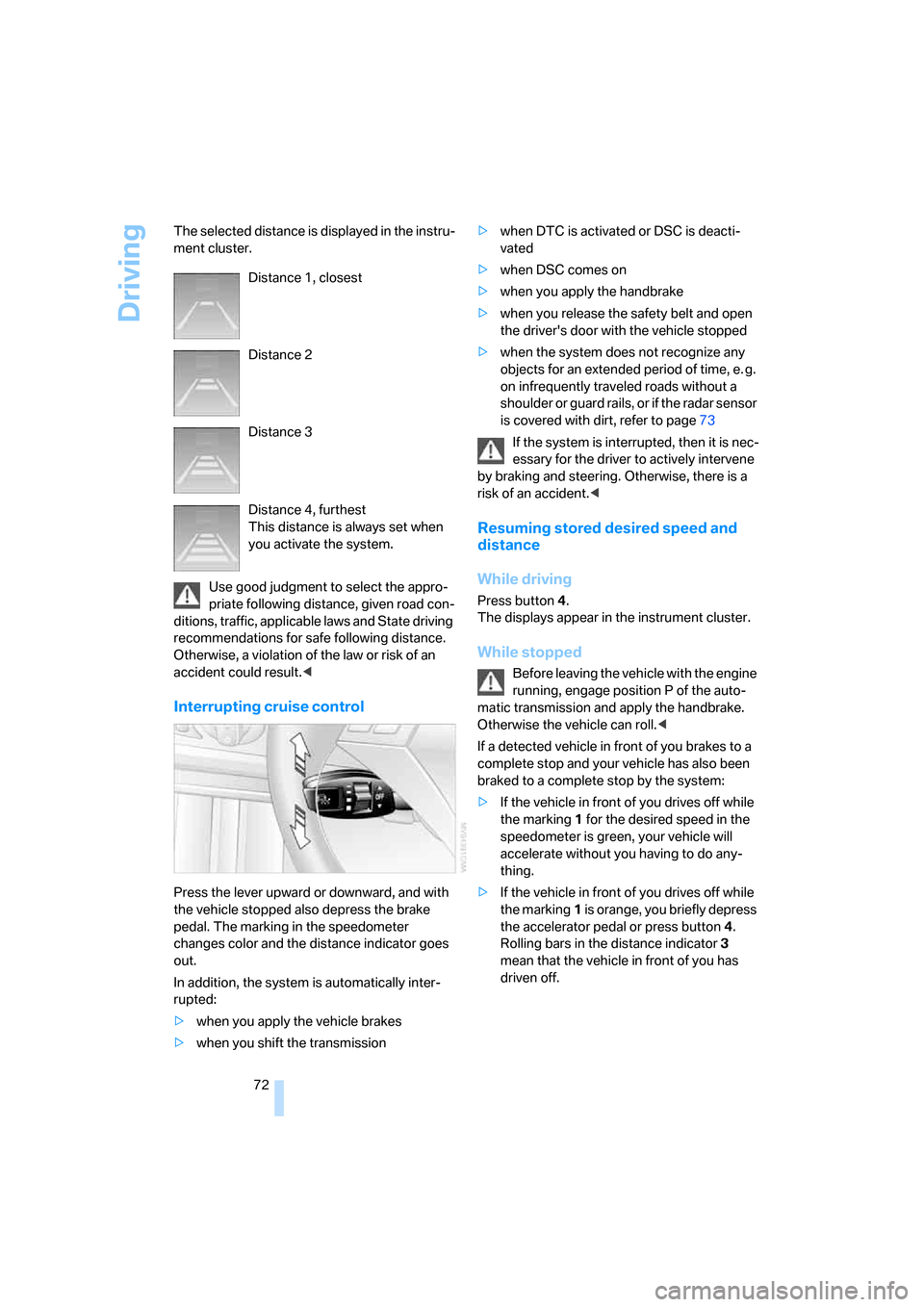
Driving
72 The selected distance is displayed in the instru-
ment cluster.
Use good judgment to select the appro-
priate following distance, given road con-
ditions, traffic, applicable laws and State driving
recommendations for safe following distance.
Otherwise, a violation of the law or risk of an
accident could result.<
Interrupting cruise control
Press the lever upward or downward, and with
the vehicle stopped also depress the brake
pedal. The marking in the speedometer
changes color and the distance indicator goes
out.
In addition, the system is automatically inter-
rupted:
>when you apply the vehicle brakes
>when you shift the transmission>when DTC is activated or DSC is deacti-
vated
>when DSC comes on
>when you apply the handbrake
>when you release the safety belt and open
the driver's door with the vehicle stopped
>when the system does not recognize any
objects for an extended period of time, e. g.
on infrequently traveled roads without a
shoulder or guard rails, or if the radar sensor
is covered with dirt, refer to page73
If the system is interrupted, then it is nec-
essary for the driver to actively intervene
by braking and steering. Otherwise, there is a
risk of an accident.<
Resuming stored desired speed and
distance
While driving
Press button4.
The displays appear in the instrument cluster.
While stopped
Before leaving the vehicle with the engine
running, engage position P of the auto-
matic transmission and apply the handbrake.
Otherwise the vehicle can roll.<
If a detected vehicle in front of you brakes to a
complete stop and your vehicle has also been
braked to a complete stop by the system:
>If the vehicle in front of you drives off while
the marking1 for the desired speed in the
speedometer is green, your vehicle will
accelerate without you having to do any-
thing.
>If the vehicle in front of you drives off while
the marking1 is orange, you briefly depress
the accelerator pedal or press button4.
Rolling bars in the distance indicator3
mean that the vehicle in front of you has
driven off. Distance 1, closest
Distance 2
Distance 3
Distance 4, furthest
This distance is always set when
you activate the system.
Page 135 of 286
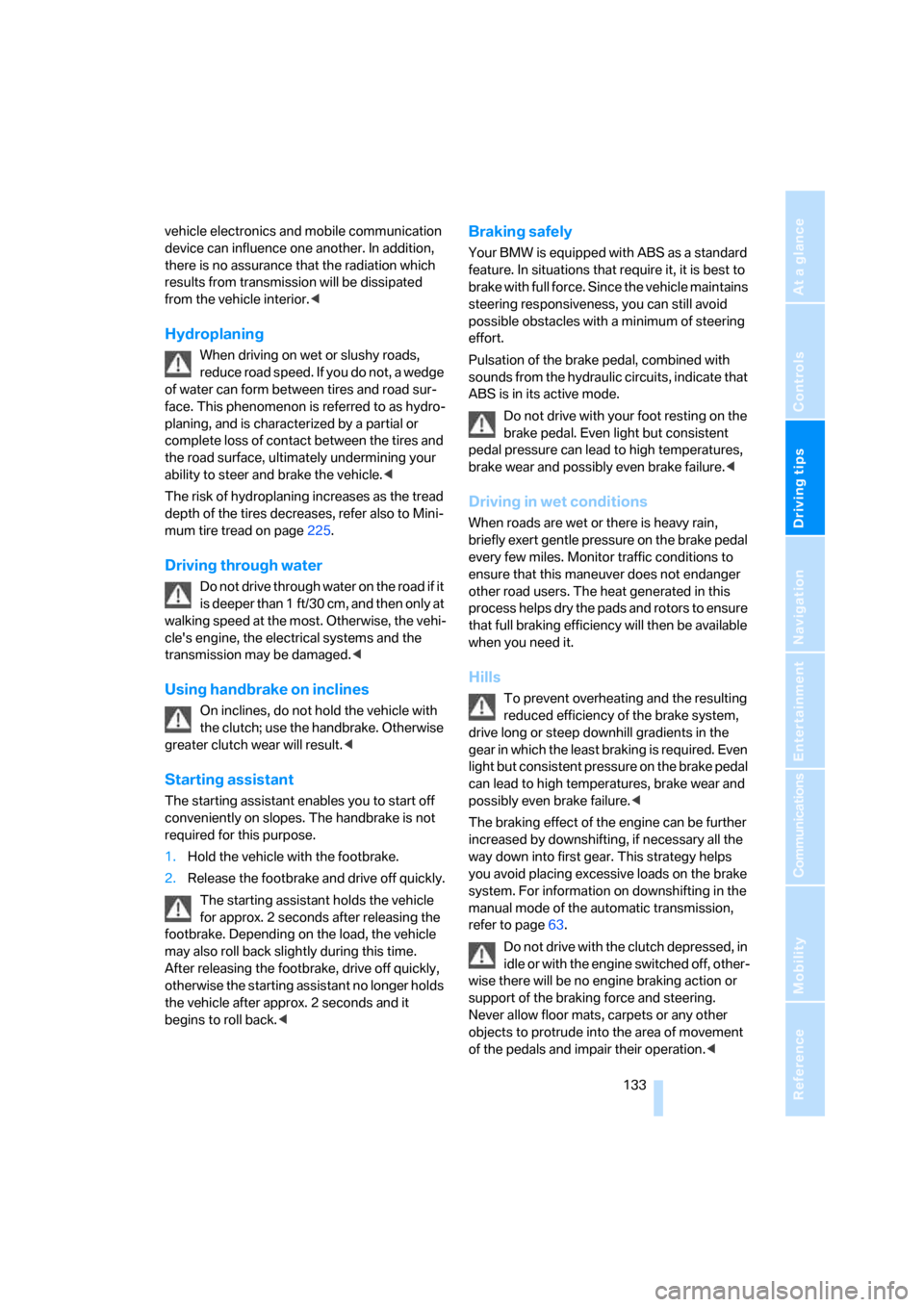
Driving tips
133Reference
At a glance
Controls
Communications
Navigation
Entertainment
Mobility
vehicle electronics and mobile communication
device can influence one another. In addition,
there is no assurance that the radiation which
results from transmission will be dissipated
from the vehicle interior.<
Hydroplaning
When driving on wet or slushy roads,
reduce road speed. If you do not, a wedge
of water can form between tires and road sur-
face. This phenomenon is referred to as hydro-
planing, and is characterized by a partial or
complete loss of contact between the tires and
the road surface, ultimately undermining your
ability to steer and brake the vehicle.<
The risk of hydroplaning increases as the tread
depth of the tires decreases, refer also to Mini-
mum tire tread on page225.
Driving through water
Do not drive through water on the road if it
is deeper than 1 ft/30 cm, and then only at
walking speed at the most. Otherwise, the vehi-
cle's engine, the electrical systems and the
transmission may be damaged.<
Using handbrake on inclines
On inclines, do not hold the vehicle with
the clutch; use the handbrake. Otherwise
greater clutch wear will result.<
Starting assistant
The starting assistant enables you to start off
conveniently on slopes. The handbrake is not
required for this purpose.
1.Hold the vehicle with the footbrake.
2.Release the footbrake and drive off quickly.
The starting assistant holds the vehicle
for approx. 2 seconds after releasing the
footbrake. Depending on the load, the vehicle
may also roll back slightly during this time.
After releasing the footbrake, drive off quickly,
otherwise the starting assistant no longer holds
the vehicle after approx. 2 seconds and it
begins to roll back.<
Braking safely
Your BMW is equipped with ABS as a standard
feature. In situations that require it, it is best to
brake with full force. Since the vehicle maintains
steering responsiveness, you can still avoid
possible obstacles with a minimum of steering
effort.
Pulsation of the brake pedal, combined with
sounds from the hydraulic circuits, indicate that
ABS is in its active mode.
Do not drive with your foot resting on the
brake pedal. Even light but consistent
pedal pressure can lead to high temperatures,
brake wear and possibly even brake failure.<
Driving in wet conditions
When roads are wet or there is heavy rain,
briefly exert gentle pressure on the brake pedal
every few miles. Monitor traffic conditions to
ensure that this maneuver does not endanger
other road users. The heat generated in this
process helps dry the pads and rotors to ensure
that full braking efficiency will then be available
when you need it.
Hills
To prevent overheating and the resulting
reduced efficiency of the brake system,
drive long or steep downhill gradients in the
gear in which the least braking is required. Even
light but consistent pressure on the brake pedal
can lead to high temperatures, brake wear and
possibly even brake failure.<
The braking effect of the engine can be further
increased by downshifting, if necessary all the
way down into first gear. This strategy helps
you avoid placing excessive loads on the brake
system. For information on downshifting in the
manual mode of the automatic transmission,
refer to page63.
Do not drive with the clutch depressed, in
idle or with the engine switched off, other-
wise there will be no engine braking action or
support of the braking force and steering.
Never allow floor mats, carpets or any other
objects to protrude into the area of movement
of the pedals and impair their operation.<
Page 266 of 286

Everything from A to Z
264 "BMW Assist"208
BMW Assist207
– activating212
– breakdown assistance208
– contacting BMW Customer
Relations210
– displaying vehicle data213
– information service210
– services offered207
– TeleService209
– updating211
"BMW Contact"202
"BMW Contact
Numbers"202
BMW homepage4
BMW maintenance
system232
BMW Night Vision103
– activating104
– cleaning camera105
– cleaning camera, refer to
Wiper system67
– deactivating104
– making settings104
"BMW Service settings"211
BMW website4
Bottle holder, refer to Cup
holders121
Bracket for telephone or
mobile phone, refer to Snap-
in adapter205
Brake assistant90
– adaptive91
Brake force display99
Brake lamps
– replacing bulbs237
– two-stage99
Brake rotors
– breaking-in132
– refer to Braking safely133Brakes
– ABS Antilock Brake
System90
– brake assistant90
– brake force display99
– breaking-in132
– CBC Cornering Brake
Control90
– electronic brake-force
distribution90
– handbrake62
– refer to Braking safely133
– warning lamps13
Brake system132
– brake pads132
– breaking-in132
– disk brakes134
– warning lamp
93
Braking safely133
Breakdown assistance208
Breakdown services, refer to
Roadside Assistance245
Breaking-in brake pads132
Breaking-in the clutch132
Breaking-in the differential,
refer to Engine and
differential132
Break-in period132
"Brightness"87,102
– with BMW Night Vision105
Brightness of Control
Display87
Button for starting engine,
refer to Start/Stop button60
Buttons on steering wheel11
C
California Proposition 65
Warning6
"Call"200,211
Call
– accepting198
– displaying accepted201
– ending199
– in absence201
– rejecting199
– starting199Calling
– by entering phone
number199
– from phone book200
– from Top 8 list201
– redialing201
– refer to telephone operating
instructions
Can holder, refer to Cup
holders121
Capacities256
Car battery, refer to Vehicle
battery242
Car care, refer to Caring for
your vehicle brochure
Car-care products, refer to
Caring for your vehicle
brochure
"Car Data"79
Care233
– refer to Caring for your
vehicle brochure
Cargo
– refer to Cargo loading134
– securing135
– securing with ski bag127
Cargo bay
– capacity255
– emergency operation, refer
to Opening manually, Sports
Wagon36
– emergency release35
– expanding, Sports
Wagon125
– floor panel flap, refer to
Compartment in floor,
Sports Wagon126
– locking separately34
– opening/closing, refer to
Luggage compartment lid/
tailgate34
– opening from inside34
– opening from inside, Sports
Wagon35
– opening from outside34
– opening from outside,
Sports Wagon35
– opening with remote
control31
Page 271 of 286
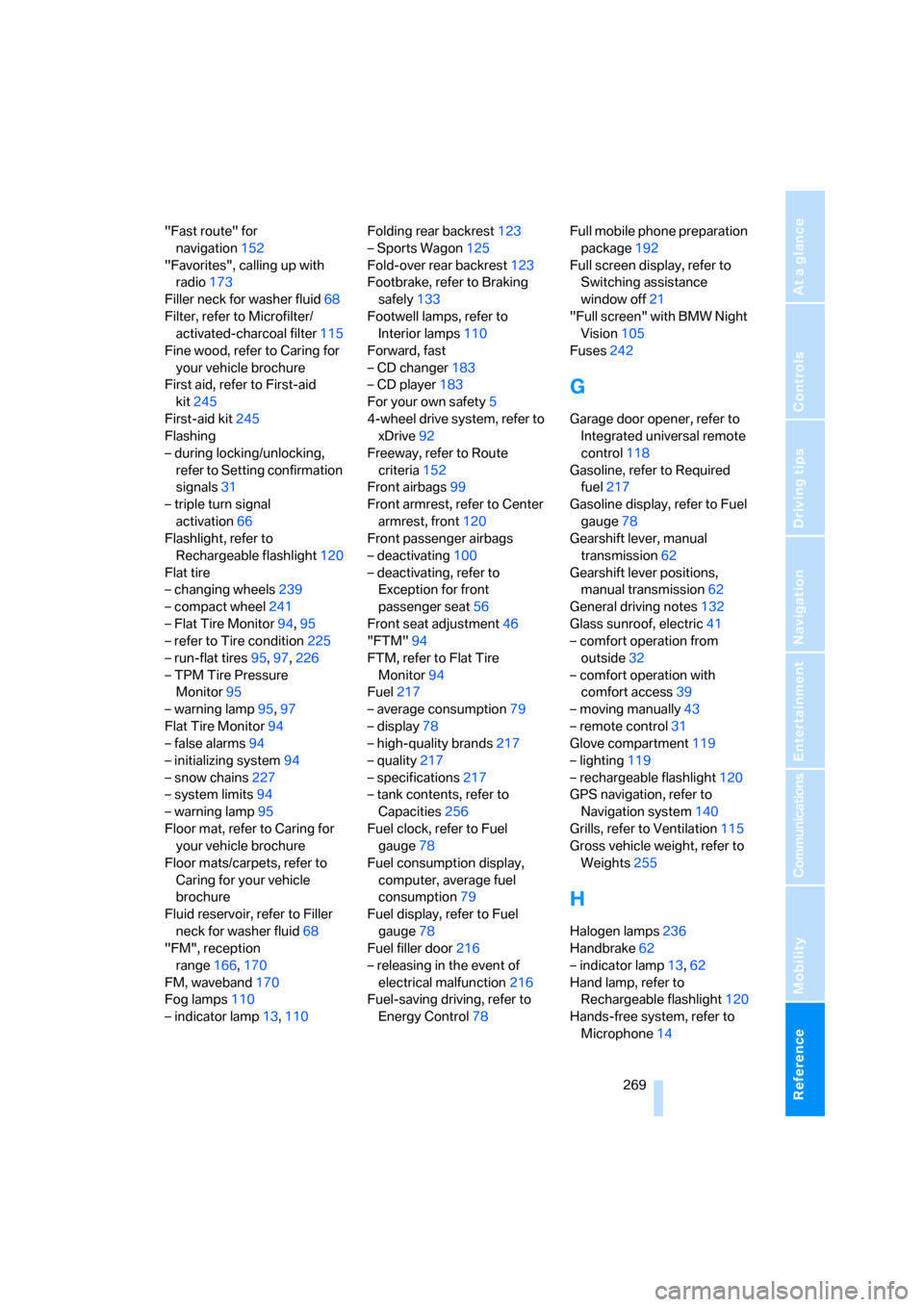
Reference 269
At a glance
Controls
Driving tips
Communications
Navigation
Entertainment
Mobility
"Fast route" for
navigation152
"Favorites", calling up with
radio173
Filler neck for washer fluid68
Filter, refer to Microfilter/
activated-charcoal filter115
Fine wood, refer to Caring for
your vehicle brochure
First aid, refer to First-aid
kit245
First-aid kit245
Flashing
– during locking/unlocking,
refer to Setting confirmation
signals31
– triple turn signal
activation66
Flashlight, refer to
Rechargeable flashlight120
Flat tire
– changing wheels239
– compact wheel241
– Flat Tire Monitor94,95
– refer to Tire condition225
– run-flat tires95,97,226
– TPM Tire Pressure
Monitor95
– warning lamp95,97
Flat Tire Monitor94
– false alarms94
– initializing system94
– snow chains227
– system limits94
– warning lamp95
Floor mat, refer to Caring for
your vehicle brochure
Floor mats/carpets, refer to
Caring for your vehicle
brochure
Fluid reservoir, refer to Filler
neck for washer fluid68
"FM", reception
range166,170
FM, waveband170
Fog lamps110
– indicator lamp13,110Folding rear backrest123
– Sports Wagon125
Fold-over rear backrest123
Footbrake, refer to Braking
safely133
Footwell lamps, refer to
Interior lamps110
Forward, fast
– CD changer183
– CD player
183
For your own safety5
4-wheel drive system, refer to
xDrive92
Freeway, refer to Route
criteria152
Front airbags99
Front armrest, refer to Center
armrest, front120
Front passenger airbags
– deactivating100
– deactivating, refer to
Exception for front
passenger seat56
Front seat adjustment46
"FTM"94
FTM, refer to Flat Tire
Monitor94
Fuel217
– average consumption79
– display78
– high-quality brands217
– quality217
– specifications217
– tank contents, refer to
Capacities256
Fuel clock, refer to Fuel
gauge78
Fuel consumption display,
computer, average fuel
consumption79
Fuel display, refer to Fuel
gauge78
Fuel filler door216
– releasing in the event of
electrical malfunction216
Fuel-saving driving, refer to
Energy Control78Full mobile phone preparation
package192
Full screen display, refer to
Switching assistance
window off21
"Full screen" with BMW Night
Vision105
Fuses242G
Garage door opener, refer to
Integrated universal remote
control118
Gasoline, refer to Required
fuel217
Gasoline display, refer to Fuel
gauge78
Gearshift lever, manual
transmission62
Gearshift lever positions,
manual transmission62
General driving notes132
Glass sunroof, electric41
– comfort operation from
outside32
– comfort operation with
comfort access39
– moving manually43
– remote control31
Glove compartment119
– lighting119
– rechargeable flashlight120
GPS navigation, refer to
Navigation system140
Grills, refer to Ventilation115
Gross vehicle weight, refer to
Weights255
H
Halogen lamps236
Handbrake62
– indicator lamp13,62
Hand lamp, refer to
Rechargeable flashlight120
Hands-free system, refer to
Microphone14
Page 276 of 286
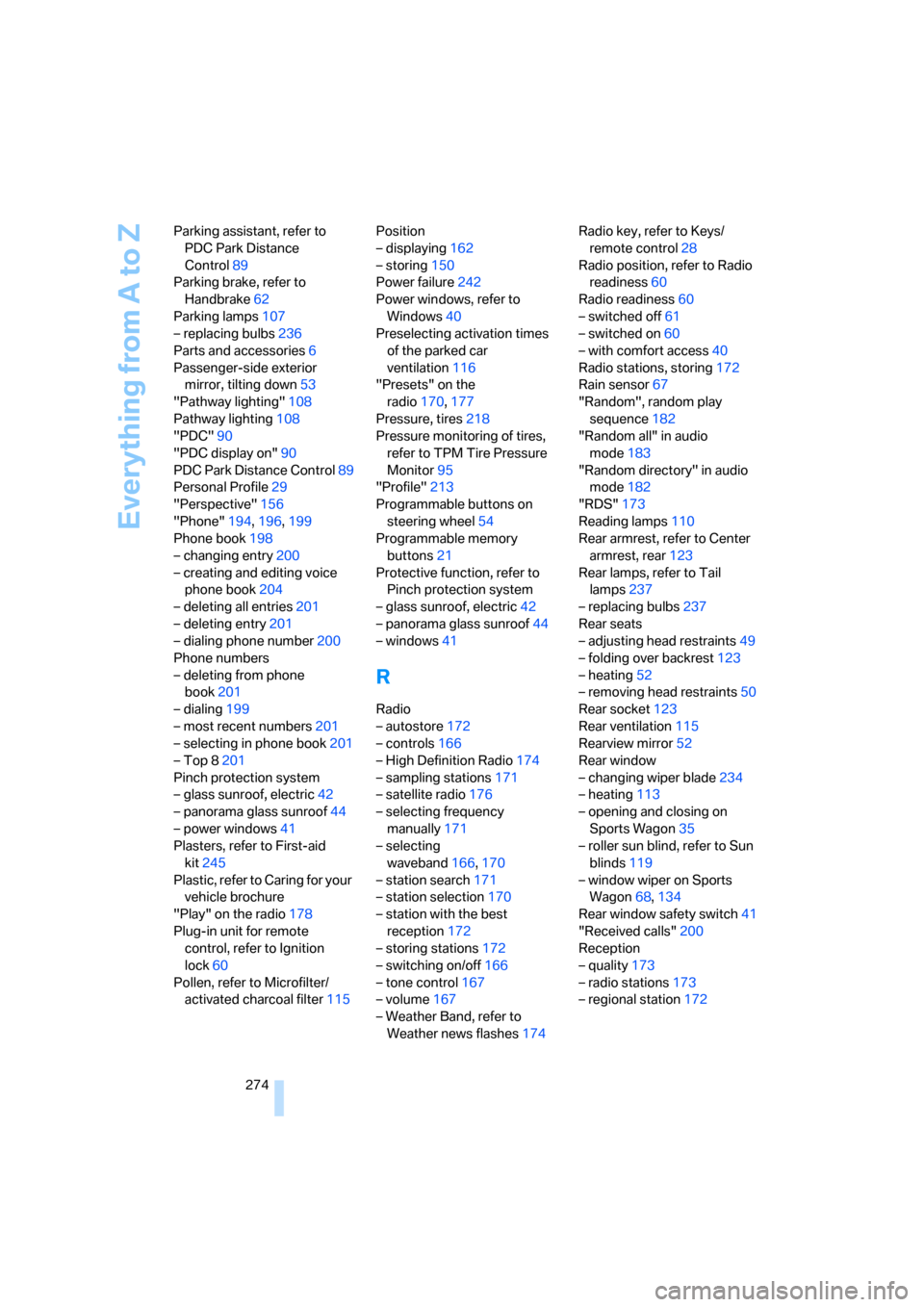
Everything from A to Z
274 Parking assistant, refer to
PDC Park Distance
Control89
Parking brake, refer to
Handbrake62
Parking lamps107
– replacing bulbs236
Parts and accessories6
Passenger-side exterior
mirror, tilting down53
"Pathway lighting"108
Pathway lighting108
"PDC"90
"PDC display on"90
PDC Park Distance Control89
Personal Profile29
"Perspective"156
"Phone"194,196,199
Phone book198
– changing entry200
– creating and editing voice
phone book204
– deleting all entries201
– deleting entry201
– dialing phone number200
Phone numbers
– deleting from phone
book201
– dialing199
– most recent numbers201
– selecting in phone book201
– Top 8201
Pinch protection system
– glass sunroof, electric42
– panorama glass sunroof44
– power windows41
Plasters, refer to First-aid
kit245
Plastic, refer to Caring for your
vehicle brochure
"Play" on the radio178
Plug-in unit for remote
control, refer to Ignition
lock60
Pollen, refer to Microfilter/
activated charcoal filter115Position
– displaying162
– storing150
Power failure242
Power windows, refer to
Windows40
Preselecting activation times
of the parked car
ventilation116
"Presets" on the
radio170,177
Pressure, tires218
Pressure monitoring of tires,
refer to TPM Tire Pressure
Monitor95
"Profile"213
Programmable buttons on
steering wheel54
Programmable memory
buttons21
Protective function, refer to
Pinch protection system
– glass sunroof, electric42
– panorama glass sunroof44
– windows41
R
Radio
– autostore172
– controls166
– High Definition Radio174
– sampling stations171
– satellite radio176
– selecting frequency
manually171
– selecting
waveband166,170
– station search171
– station selection170
– station with the best
reception172
– storing stations172
– switching on/off166
– tone control167
– volume167
– Weather Band, refer to
Weather news flashes174Radio key, refer to Keys/
remote control28
Radio position, refer to Radio
readiness60
Radio readiness60
– switched off61
– switched on60
– with comfort access40
Radio stations, storing172
Rain sensor67
"Random", random play
sequence182
"Random all" in audio
mode183
"Random directory" in audio
mode182
"RDS"173
Reading lamps110
Rear armrest, refer to Center
armrest, rear123
Rear lamps, refer to Tail
lamps237
– replacing bulbs237
Rear seats
– adjusting head restraints49
– folding over backrest123
– heating52
– removing head restraints50
Rear socket123
Rear ventilation115
Rearview mirror52
Rear window
– changing wiper blade234
– heating113
– opening and closing on
Sports Wagon35
– roller sun blind, refer to Sun
blinds119
– window wiper on Sports
Wagon68,134
Rear window safety switch41
"Received calls"200
Reception
– quality173
– radio stations173
– regional station172